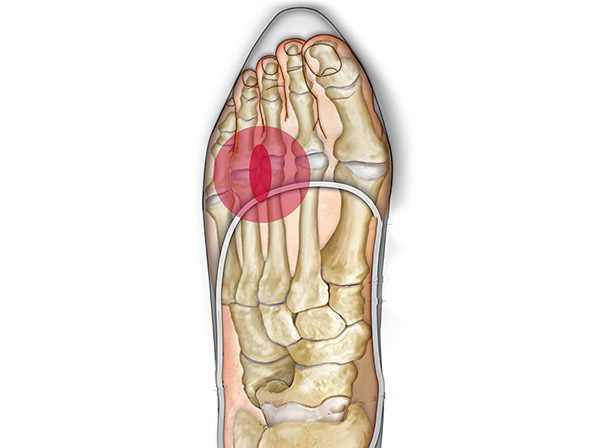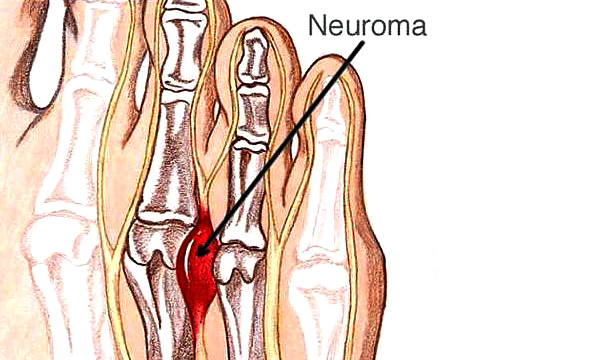Morton’s Neuroma is a painful foot condition that is also referred to as a “pinched nerve”, or a nerve tumor. It is a benign growth of nerve tissue frequently found between the third and fourth toes that bring on a combination of symptoms such as pain, burning sensation, tingling, or numbness between the toes and also in the ball of the foot.
The principal complaint associated with a neuroma is pain between the toes while walking. Those suffering from this condition often find relief by stopping their walk, taking off their shoe, and rubbing the affected area. At times, patients will describe pain as similar to having a stone in his or her shoe. Morton’s Neuroma can occur in adults of all age groups although it occurs more often in women than men. It usually affects one foot but both may be affected. It occurs most commonly between the 3rd and 4th metatarsals near the ball of the foot.
Symptoms:
- Pain in the forefoot and between the toes (usually 3rd and 4th).
- Tingling and numbness in the ball of the foot and toes.
- Swelling between the toes.
- Increase pain in the ball of the foot when weight bearing.
How Do I Know I Have A Neuroma?
- Clinical examination by a physician specialized in the foot (usually feels for a palpable click between the metatarsal heads).
- Diagnostic Ultrasound imaging can be used to visualize the neuroma
- Diagnostic local anesthetic injections can be used to localize the location of the neuroma
- The doctor may also order x-ray of the foot to rule out other foot pathologies.

Ill-fitting shoes, such as shoes with narrow width can lead to nerve impingement and thus irritation of the metatarsal nerve.
Why Does Neuroma Occur?
Although the exact cause for this condition is unclear, a number of factors can contribute to the formation of neuroma:
- Metatarsals, the bones on either side of the nerve cause narrowing in this area leading to nerve inflammation and thickening.
- Biomechanical deformities, such as a high arched foot or a flat foot, can lead to the formation of a neuroma. These foot types result instability around the toe joints, leading to the development of this condition.
- Trauma can cause damage to the nerve, resulting in inflammation or swelling of the nerve.
- Improper, tight footwear that causes the metatarsals and toes to be squeezed, causes impingement on the nerve.
- Repeated stress, common to many occupations or sporting activities, can aggravate the nerve.

Neuroma – enlargement of metatarsal nerve due to chronic irritation.
What Can I Do for Relief?
- Wear shoes with plenty of room for the toes to move, low heels, and laces or buckles that allow for width adjustment.
- Wear shoes with thick, shock-absorbent soles and proper insoles that are designed to keep excessive pressure off of the foot.
- High heels should be avoided whenever possible because they place undue strain on the forefoot and can contribute to a number of foot problems.
- Resting the foot and massaging the affected area can temporarily alleviate neuroma pain. Ice pack can also be helpful.
What Will Happen If I Don’t Have My Neuroma Treated?
For simple, undeveloped neuromas, the above is often adequate to alleviate symptoms. For more severe conditions, or if pain is not improving, it is important to seek evaluation and further treatment from a foot specialist. The following can occur if neuroma is left untreated:
- Growth of the neuroma.
- Increased discomfort in the area.
- Inability to wear certain shoes.
- Inability to perform some job duties.
- Need for surgical removal (See Neuroma Surgery).
Treatment
Treatment options from a foot doctor may vary depending on severity of the neuroma. These may include:
- Special padding under the ball of the foot to reduce pressure
- Orthotic device to control abnormal foot function
- Medications such as anti-inflammatory drugs
- Injections can be performed to reduce inflammation of the nerve
- Surgery – learn more about surgical options.
Remember – you don’t have to live with foot pain! Conservative treatment prescribed by a foot doctor has 80-90% chance of relieving symptoms. Early conservative treatment improves your chance of avoiding future surgery. Our doctor is able to offer a wide range of treatment for neuroma pain, from conservative to surgical. Contact us today if you experience neuroma symptoms and would like us to help!

